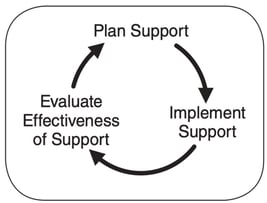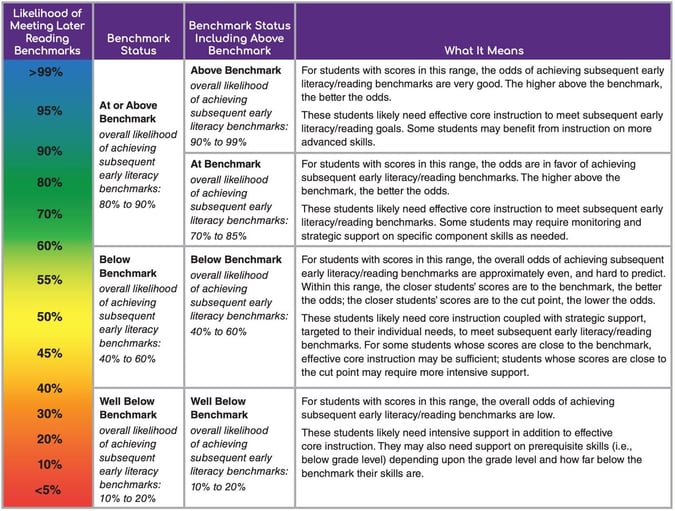Understanding Benchmarks and Cut Points for Risk
Acadience Reading provides two types of scores at each benchmark assessment period:
- A raw score for each individual measure and
- A composite score (the Reading Composite Score).
Each of the scores is interpreted relative to benchmarks and cut points for risk to determine if a student’s score is at or above the benchmark, below the benchmark, or below the cut point for risk (well below the benchmark).
Acadience Reading benchmarks are empirically derived, criterion-referenced target scores that represent adequate reading skill for a particular grade and time of year. Benchmarks and cut points for risk are provided for the Reading Composite Score as well as for the individual Acadience Reading measures. Benchmarks and cut points for Acadience Reading are based on research that examines the predictive validity of a score on a measure at a particular point in time, compared to later Acadience Reading measures and external outcome assessments.
A benchmark indicates a level of skill at which students are likely to achieve the next Acadience Reading benchmark or reading outcome. Thus, for students who achieve a benchmark, the odds are in their favor of achieving later reading outcomes if they receive effective core reading instruction.
Conversely, the cut points for risk indicate a level of skill below which students are unlikely to achieve subsequent reading goals without receiving additional, targeted instructional support. For students who have scores below the cut point for risk, the probability of achieving later reading goals is low unless intensive support is provided.
The Acadience Reading benchmarks and cut points for risk provide three primary benchmark status levels that describe students’ performance:
- At or Above Benchmark
- Below Benchmark
- Well Below Benchmark
These levels are based on the overall likelihood of achieving specified goals on subsequent Acadience Reading assessments or external measures of reading achievement.
At or Above Benchmark
For students who score at or above the benchmark, the overall likelihood of achieving subsequent reading goals is approximately 80% to 90%. These students are likely to need effective core instruction to meet subsequent early literacy and/or reading benchmarks. Within this range, the likelihood of achieving subsequent benchmarks is lower for students whose scores are right at the benchmark and increases as scores increase above the benchmark. A score at or above the benchmark indicates that the odds are in the student’s favor of achieving the next benchmark, but it is not a guarantee. For example, if students at or above the benchmark have an 85% chance of meeting the next benchmark, that means that 15% of students in the benchmark range may not achieve the subsequent benchmark. Some students who achieve scores at or above the benchmark may still need supplemental support to achieve the next benchmark. It is important to attend to other indicators of risk when planning support for students, such as attendance, behavior, motivation, vocabulary and language skills, and other related skill areas.
To assist in setting ambitious goals for students, the At or Above Benchmark level is subdivided into At Benchmark and Above Benchmark levels.
At Benchmark. In the At Benchmark range, the overall likelihood of achieving subsequent early literacy and/or reading benchmarks is 70% to 85%. Some of these students, especially those with scores near the benchmark, may require monitoring and/or strategic support on specific component skills.
Above Benchmark. In the Above Benchmark range, the overall likelihood of achieving subsequent early literacy and/or reading benchmarks is 90% to 99%. While all students with scores in this range will likely benefit from core support, some students with scores in this range may benefit from instruction on more advanced skills.
Below Benchmark. Between the benchmark and cut point for risk is a range of scores where students’ future performance is more difficult to predict. For students with scores in this range, the overall likelihood of achieving subsequent early literacy and/or reading benchmarks is approximately 40% to 60%. In this range, a student’s future performance is harder to predict. These students are likely to need strategic support to ensure their achievement of future benchmarks. Strategic support generally consists of carefully targeted supplemental support in specific skill areas in which students are having difficulty. To ensure that the greatest number of students achieve later reading success, it is best for students with scores in this range to be monitored regularly to ensure that they are making adequate progress and to receive increased or modified support if necessary to achieve subsequent reading benchmarks.
Well Below Benchmark. For students who score below the cut point for risk, the overall likelihood of achieving subsequent early literacy and/or reading benchmarks is low, approximately 10% to 20%. These students are identified as likely to need intensive support. Intensive support refers to interventions that incorporate something more or something different from the core curriculum or supplemental support. Intensive support might entail:
- Delivering instruction in a smaller group or individually
- Providing more instructional time or more practice
- Presenting smaller skill steps in the instructional hierarchy
- Providing more explicit modeling and instruction
- and/or Providing greater scaffolding and practice
Because students who need intensive support are likely to have individual needs, we recommend that their progress be monitored frequently and their intervention modified dynamically to ensure adequate progress.
Plan, Implement, and Evaluate Support Cycle from the Outcomes-Driven Model

These progress monitoring steps from the Outcomes-Driven Model provide an intervention feedback loop. By planning, implementing, and evaluating the effectiveness of support in an ongoing loop, the intervention can be modified dynamically to meet the student's needs.
To gain a better understanding of what Acadience Reading results mean in a local context, districts and schools can examine the linkages between the Acadience Reading benchmarks and cut points for risk and their own outcome assessments, such as state-level criterion-referenced tests. By comparing Acadience Reading measures to an outcomes assessment (e.g., Buck & Torgesen, 2003; Wilson, 2005), and by calculating conditional probabilities (e.g., “80% of students at benchmark on Acadience Reading ORF at the end of third grade met the Proficient level on the state criterion-referenced test”), schools can determine how the Acadience Reading benchmarks compare to their own external criteria.
The following table summarizes the design specifications for achieving later reading outcomes and provides descriptions for the likely need for support for each of the benchmark status levels. It is important to note that while there is an overall likelihood for each benchmark status level, within each level the likelihood of achieving later reading outcomes increases as students’ scores increase. This is illustrated in the first column.
Student Performance Interpretations

The addition of the Above Benchmark status level has not changed the benchmarks. A benchmark is still the point at which the odds are in the student’s favor of meeting later reading benchmarks (approximately 60% likelihood or higher). The higher above the benchmark the student scores, the better the odds. For students who are already at benchmark, the Above Benchmark status level also provides a higher target to aim for. “Overall likelihood” refers to the approximate percentage of students within the category who achieve later benchmarks, although the exact percentage varies by grade, year, and measure. Instructional decisions should be made based on students’ patterns of performance across all measures, in addition to other available information on student skills, such as diagnostic assessment or in-class work.
For more information please see the Assessment Manual located on the
